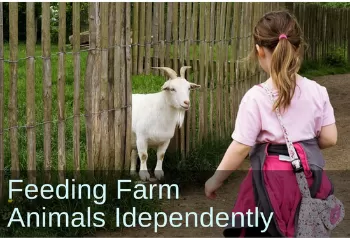Primitive Reflex Integration Case Studies
Girl Reaches Goal of Feeding Rabbits After Only 6 Sessions of the 5-Step Balance Process
Help to complete multi-step tasks; improved handwriting.
This little girl with a history of trauma came to OT for issues completing multi-step activities, poor hand skills, and sensory sensitivities that limited her participation in daily tasks. After approximately six sessions using movements from the Brain and Sensory Foundations program, she was able to independently complete 3-4 step activities such as feeding the rabbits and goats at her foster home, boosting her joy and self-esteem.
Submitted by Mariah P., Occupational Therapist

| Before | After |
|---|---|
| Challenges completing multi-step tasks, e.g., has difficulties completing the steps required to feed the rabbits; has not attempted the more complicated task of feeding the goats | Able to independently feed the rabbits; beginning to learn how to feed the goats -- both are a confidence booster |
| Handwriting difficulties | Improved handwriting |
My client is a nine-year-old girl, who will be referred to as Sammy. Sammy is a foster care child with a history of sexual abuse. Due to being in foster care and poor follow through of her medical care as a younger child, Sammy does not have an official diagnosis and has not been followed consistently enough by a physician to receive a diagnosis.
Sammy came to me for occupational therapy due to concerns with her ability to complete multi-step activities, poor hand skills, and sensory sensitivities that limit her participation in daily tasks. Sammy has difficulties with tooth brushing, handwriting, using utensils, and tolerating a variety of food textures and flavors.
Sammy’s foster home is located on a farm with over 25 animals to care for. Since being placed in this home, Sammy has developed a passion for caring for the rabbits and goats on the farm. However, Sammy has difficulties completing all the steps required to feed the rabbits and has not attempted to feed the goats as this is an even longer process than feeding the rabbits. Sammy wants to improve her ability to care for the animals.
Due to her history of trauma, Sammy became overwhelmed during the testing. Therefore, I completed testing over several sessions and started with only testing the reflexes I was most concerned about. Eventually, I was able to identify that Sammy has unintegrated TLR and STNR. I taught Sammy and her foster mother how to complete rhythmic movements and gave them the assignment to do these daily. Rhythmic movements did not cause an emotional reaction for her. Sammy was able to tolerate TLR integration activities better than STNR activities.
Since Sammy had a specific, self-directed goal in mind (feeding the rabbits) and would benefit from reflex integration activities, we decided to do a Five Step Balance Process [from the Brain and Sensory Foundations program]. Initially, Sammy used rhythmic movements for the third step of this process as she was already comfortable with these and felt safe doing these with me while we were still building a trusting relationship.
After approximately six sessions, Sammy was able to independently feed the rabbits at her foster home and was beginning to learn how to feed the goats. She presented with an overwhelmingly improved self-esteem and confidence in this skill and was clearly more joyful than when we first met. Sammy improved her handwriting skills, attention to activities, and ability to complete 3-4 step activities.
Until this experience, I always struggled on how to assist my clients in improving their abilities to complete multiple-step directions and how to approach clients with a significant history of trauma without causing stress or anxiety. This experience taught me a very effective way to handle each of these scenarios.
[Edited for length and clarity; emphasis added]
*Disclaimer: The activities in the Brain and Sensory Foundations curriculum make use of the natural processes of neuroplasticity and development that are innately wired in the design of human beings to promote maturity and function. These activities appear to calm, organize, and mature the neuro-sensory-motor systems just as we see in the healthy development of human infants. Individual results may vary, and we do not claim to offer a diagnosis or cure for any specific condition or disorder. The Brain and Sensory Foundations activities appear to improve overall functioning resulting in measurable improvements for a range of conditions as demonstrated in over 1800 case studies from participants.

